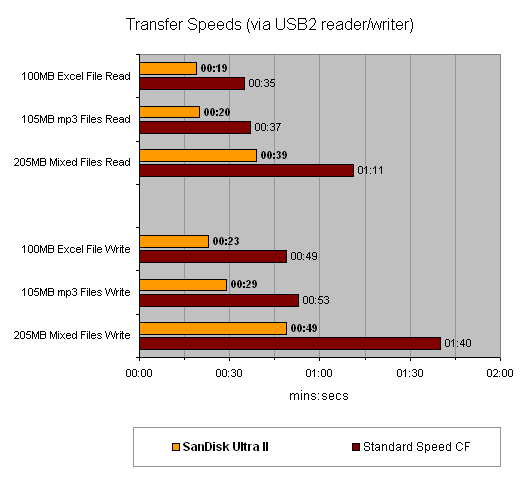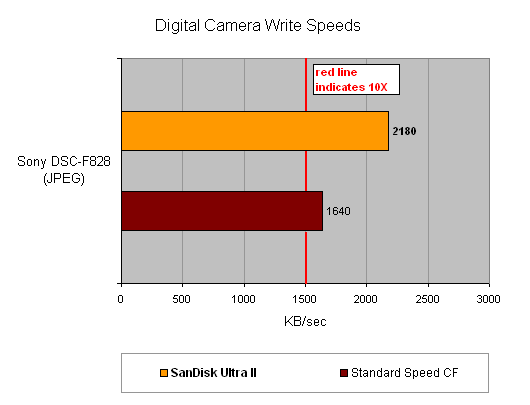SanDisk Ultra II 256MB CompactFlash Card Review
SanDisk Ultra II 256MB CompactFlash Card
As the popularity and variety of digital cameras continues to grow, SanDisk may have the CompactFlash card you've been looking for.

Verdict
Key Specifications
- Review Price: £32.00
As the world’s largest supplier of flash memory products, SanDisk is a company that’s well respected among advanced and professional digital photographers. Indeed, it is this type of more demanding user that SanDisk’s latest Ultra II range of memory cards has been designed for. SanDisk claim the Ultra II can support a minimum sustained write speed of 9MB/sec and a read speed of 10MB/sec, and as such is well suited to the latest high megapixel digital cameras. As it happens, I’m hoping to take delivery of a new eight megapixel digital SLR in the next few weeks so I was extremely interested to find out what the Ultra II has to offer.
I was sent a 256MB CompactFlash card for testing, which currently retails for around £32. However, that amount of storage is unlikely to be sufficient for most professional camera users out there so it should come as no surprise to hear that the Ultra II is also available in capacities of up to 2GB. The 512MB and 1GB sized cards can be purchased for £51.50 and £88.40 respectively, while the largest 2GB version will set you back £176.80. When looked at in terms of pounds per megabyte, it is the larger capacity cards that currently offer the best value for money.
Although CompactFlash is probably the most popular card format at the moment, not all high-end digital cameras support it. Fortunately, the Ultra II range is also available in SD and Memory Stick PRO formats, with maximum capacities of 512MB and 1GB respectively. Naturally, all three types of memory card are compatible with a whole host of other digital devices such as MP3 players, PDAs an card readers.
In terms of performance, the high speed Ultra II CF card turned in some fairly respectable results using our standard set of file transfer tests. For example, writing 205MB of mixed files from a PC to the SanDisk card via a USB2.0 card reader/writer took just 49 seconds, which was more than twice as fast as a typical consumer orientated CompactFlash card. Read speeds were equally impressive with the Ultra II card taking 39 seconds to copy back the 205MB of mixed files, compared with 71 seconds using the standard CF card. Taking the fastest times for reading and writing, and converting them to MB/sec, the results of 5.3MB/s and 4.3MB/s are obtained, respectively. These do not match the stated speeds from Sandisk, but are likely to be closer to “real world” speeds.

I also decided to see how the Ultra II compared against our standard CF card when used in one of the latest high megapixel digital cameras. Ideally, I would liked to have tested the Ultra II using a professional digital SLR, as they tend to have much faster memory interfaces than consumer cameras, but unfortunately I couldn’t get hold of one in time. So instead, I used one of the very latest ‘prosumer’ orientated cameras – an eight megapixel Sony DSC-F828. The tests consisted of shooting several photos in quick succession and timing how long the camera’s memory access lamp remained illuminated. The total size of each set of files was then calculated separately for each card and divided by the recorded time to obtain an average write speed. In both cases, the write speed via the Sony’s CF interface was pretty impressive, but it was the Ultra II card that delivered the significantly better write performance, equivalent to nearly 15X (where 1X equals 150KB/sec).

Anyway, that’s enough about performance for the time being – what else does the SanDisk card have to offer? Well, more often than not with an IT product such as a memory card, it doesn’t come as too much of a surprise if when you open the packaging, you find nothing inside but the card itself. Thankfully, the Ultra II range differs from other flash products in this respect since SanDisk has bundled in a copy of their own RescuePRO data recovery software. Designed to recover images and other files that you may have inadvertently deleted, RescuePRO will scan your flash card and display a preview of any recoverable data. You can then choose to restore some or all of the recovered images or files to another directory on your PC.
To test the software out, I first copied a number of JPEG images from my PC to the Ultra II card using the USB2.0 reader. I then deleted the images in Windows, and also formatted the card a couple of times to try and make doubly sure that there were no traces of the files left. However, all this effort proved to be in vain. After scanning the card for a minute or so, the software successfully recovered all of the JPEG files and allowed me to resave them to my PC’s hard disk.
Because the SanDisk software will also work with memory cards from other manufacturers, I thought I’d see what it could find on one of my own (heavily used) CF cards. Again, after plugging the card into the USB2.0 reader I first formatted the card twice before scanning for lost images. To my amazement I was able to recover about a dozen photos that I’d taken – and thought I’d deleted – several months ago. I must admit, the RescuePRO software worked so well I found it quite worrying to think it was possible for potentially sensitive data of any kind to be recovered so easily. Fortunately, if data security is a particular issue then the SanDisk software is also capable of permanently erasing any files on a flash card.
Finally, as a testament to its professional status the Ultra II product line is covered by an impressive ten-year warranty should a fault develop with your particular flash card. This is undoubtedly more generous than the much shorter warranties offered by some other companies, although I do know of at least one flash memory card manufacturer that offers a lifetime guarantee with its products. Nevertheless, at their current prices the SanDisk Ultra II cards do still present good value for money, even for the consumer user.
”’Verdict”’
Although we couldn’t match SanDisk’s claimed transfer rates, it is competitively priced, comes bundled with a useful software package, and is roughly twice as fast as a standard speed CompactFlash card. If you own one of the latest high megapixel digital cameras capable of fast read and write times, then you should certainly give the Ultra II some consideration, albeit probably in a larger capacity.
Trusted Score
Score in detail
-
Value 8
-
Features 8

